|
By Half-dude - 10 Years Ago
|
Hello guys,
This is my first post, I hope to make some friends here.  I'm 27 and my family owns a 55 Ford Town Sedan, I've done all the work myself to get her back running again and we just took her on our first long high speed test-drive 16 miles there and back at about 55-60mph consistently. Anyway, the engine sounded great, when she's going she does great. We still have a bit of a problem with the ending wanting to stall out on a hot engine when we slow to a stop but as long as I feather the gas she keeps going. Probably a bad auto-choke. (this is a fordomatic btw). I'm 27 and my family owns a 55 Ford Town Sedan, I've done all the work myself to get her back running again and we just took her on our first long high speed test-drive 16 miles there and back at about 55-60mph consistently. Anyway, the engine sounded great, when she's going she does great. We still have a bit of a problem with the ending wanting to stall out on a hot engine when we slow to a stop but as long as I feather the gas she keeps going. Probably a bad auto-choke. (this is a fordomatic btw).
Anyway that's not the real question. About 16 miles in when we were getting to our destination I noticed the stock temp gauge was reading a really high temperature, like just entering the red-line. Now firstly I don't know if these old engines are supposed to run at the same temp on the gauge as modern cars, should they stay about at the center of the gauge between C and H? Or do those old engines run hotter normally?
I had a friend with me, an older man who's good with car. When we parked her we opened the hood and he said that the engine wasn't overheating, he was touching the engine with his hand and said if it were he wouldn't even be able to do that. He said the radiator also wasn't 'gurgling.' I suppose yeah it wasn't SUPER hot, I touched it too. You wouldn't want to keep your hand on it, but yeah you could hold it on there a few seconds before it'd start to hurt.
I guess I'm just curious, could my old gauges be mis-reading? I know the gauges default to reading hot when the car is off, so maybe if it's mis-reading it'll naturally mis-read hotter rather then colder?
|
|
By Ted - 10 Years Ago
|
|
Assuming your car is still a six volt system, the temperature gauge typically runs slightly to the cool side when everything is normal. If the car has been converted to twelve volts, then the factory gauges may not be reading as they were originally depending upon how the voltage to the gauges is being reduced. Beyond all that, I’d suggest a known good mechanical gauge to get a better idea of what the actual running coolant temperature is. If the engine is not losing or boiling out any coolant, then it’s not running hot enough to damage anything at this point.
|
|
By Half-dude - 10 Years Ago
|
Yes, she's an original 6v system, just replaced the voltage regulator and rebuilt the alternator as a matter of fact.
Well that's good to know, maybe I'll check to see if there are any temperature guns you can rent at the O'Riley's or Autozone and see what temperature I get at the thermostat housing like I've seen some people suggesting. Interestingly enough my fuel gauge doesn't work at all. I thought it was a flooded tank float, which was the case as it turned out, but I recently changed the tank out with a new one and it came with a new sender unit. It's the correct ohm rating and everything but the gauge still wont budge.
|
|
By Ted - 10 Years Ago
|
|
Alternator or generator?
|
|
By Half-dude - 10 Years Ago
|
Sorry, I meant generator.
|
|
By miker - 10 Years Ago
|
Welcome to the site. Just as an aside, you can buy infrared heat guns on Amazon for under $20.00. I did some A/C work at the house last week, and the cheapo gun read within 1/2 degree of the tech's expensive Fluke. They don't have the distance range, but they get close enough to check the upper/lower radiator, hoses, etc. Check it against a pot of water just coming to a boil, and you'll know where 212 F is, and that's close to our running temps at 180 or so.
And you can get the griddle just right to make perfect pancakes when you're in the kitchen.
|
|
By Rowen - 10 Years Ago
|
|
Mmmmm......pancakes......Mmmm
|
|
By Half-dude - 10 Years Ago
|
You know, this idea just came to me. I have the heater fan and housing off the car for the moment, I'm going to get it repainted. but I'm wondering, would that effect the heat under the hood there, having the heater-core exposed in the firewall like that? I never thought about that..
Here's a couple pictures of my car for you guys to see btw if you're interested. 
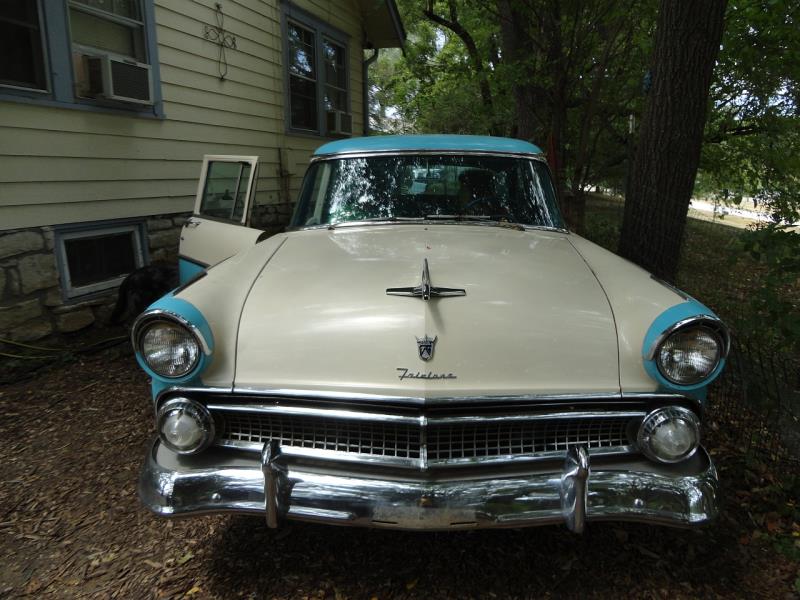
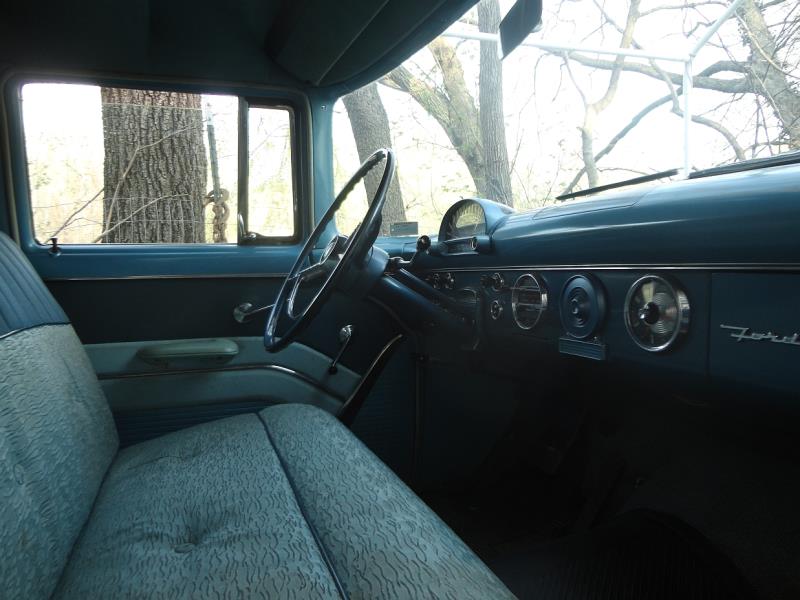
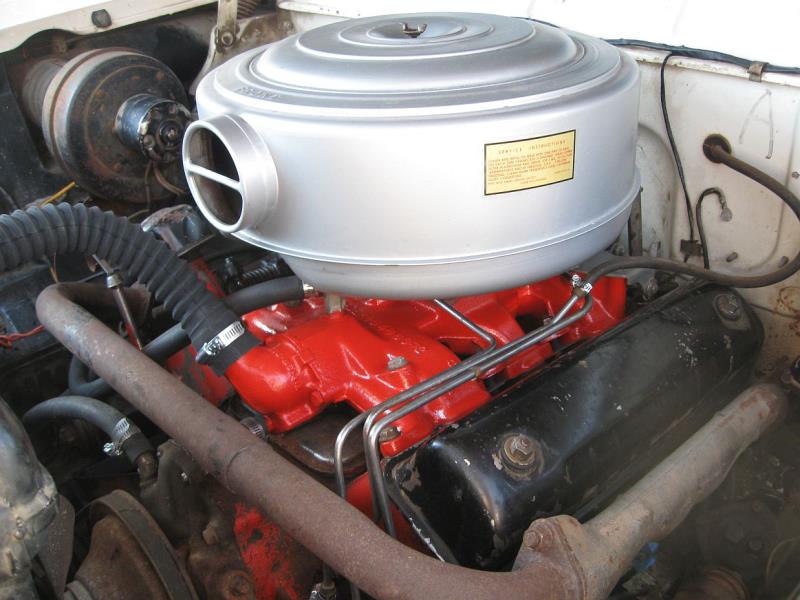
|
|
By Rowen - 10 Years Ago
|
|
That sounds reasonable but I really have no idea on exposed core. This is just to say welcome and you have
|
|
By Rowen - 10 Years Ago
|
|
Dang fat fingers!! I HATE this "I" phone!! Now, as I was saying before my fingers got in the way, nice ride!! These folks can and WILL help in any way they can! Enjoy your new Y block!! Rowen
|
|
By Dobie - 10 Years Ago
|
Half-dude (8/21/2015)
You know, this idea just came to me. I have the heater fan and housing off the car for the moment, I'm going to get it repainted. but I'm wondering, would that effect the heat under the hood there, having the heater-core exposed in the firewall like that? I never thought about that.. Here's a couple pictures of my car for you guys to see btw if you're interested.  Nice ride! Th exposed heater core should make little to no difference in under hood temps unless the heater valve is open, and even then it would be tiny compared to the normal under hood heat. I think your gauge is on the fritz.   
|
|
By Meandean - 10 Years Ago
|
My 55 Fairlane 272 was about the same situation. Also a Ford-o-matic. Seemed to run hot, especially if I had to idle for a few minutes. Parades? Forget about it.
I purchased a direct fit aluminum replacement radiator from an outfit in MN. I can't remember the company, but they advertise in the CVA newsletter. I could look it up if you want. It wasn't too bad - about $240 as I recall. I changed that and changed out the original fan for a 5 blade unit and it runs right in the middle of the gauge now. I even had it in a Parade on July 4th!
Only wrinkle was the made-to-fit radiator was about 1/2 an inch too tall to fit with the hood closed! Good thing it was noticed before it got slammed shut. So I had to do some finagling to make it work.
|
|
By DryLakesRacer - 10 Years Ago
|
My 56 acted the same..after much work I followed Greenbirds suggestion to look at the water in the radiator when the car was up to temperature and at idle in gear. If the water was not moving reach over and raise the idle to see if the water moves. It did then. His suggestion was to speed up the water pump but installing a smaller pully. I used one off a 289/302 early Mustang. I needed to space it out about 1/8" for the belt to line up. I bought everything from Summit but the shorter belt. Heat up problem was gone. I had changed the rad to a larger one and it made no difference. I was moving towards a fan shoud when I changed the pully. Good Luck
|
|
By 55 GLASS TOP - 10 Years Ago
|
|
I did not read your whole post but , sometime when the heat riser on the manifold is rusty and stuck it will raise the temp of the engine if the car has been sitting for a long time there is a chance the riser is rusted in place its easy to check it either moves or its stuck inspect it when its cold
|
|
By Half-dude - 10 Years Ago
|
Thanks guys, I like your suggestions, maybe it does need a new radiator I don't know. I keep wondering if I got the wrong thermostat, I got it at O'Reily's and asked them to look up what the right one for a 55 would be.. would modern thermostats not open the same temperature as a 55's?
I'm kinda concerned now, before I was getting readings of overheating without any signs on the engine. Today though, after I did a valve lash adjustment on the engine, I took it for a test drive. On that note I can't tell if my adjustment fixed anything, the engine still seems to clatter when it runs especially when increasing speed.. I don't know how the engine should normally sound honestly.
Anyway I was nearing the end of the loop heading home when the car started acting up again. I noticed the car sounding.. different, hard to really explain as it's not very loud and kind of hard to hear from inside but the above mentioned clatter seemed to go in and out intermitently and I almost heard what sounded like a grinding.. at least I hope that's not what it was. The engine wouldn't stall out which was an improvement.. but it was running weaker. The most evident thing was the white smoke bellowing out of the tailpipe. ><
I got her home and shut her off, looked over the engine and I indeed heard that infamous bubbling in the radiator, sounded like it was frothing and churning in there and it was dripping out of the overflow.. not a ton just a bit of drippage.
I'm feeling really bad guys! I know this is a good classic engine, with low mileage, I don't want to destroy it by repeatedly overheating it.. I just don't know what to do, and I'm hoping really badly that I didn't damage something today.
|
|
By charliemccraney - 10 Years Ago
|
Thermostats generally operate at the same range of temperatures, though modern cars do tend to run hotter by design.
It sounds like it is overheating. What temperature rating is the thermostat you installed? Did you install it in the correct orientation? They usually have an arrow indicating the direction of flow or the words "radiator side".
If the radiator is original, it probably wouldn't hurt to take it to a radiator shop to be cleaned and tested. It would be a good idea to replace all hoses to make sure one is not collapsing or full of crud, preventing flow. If you don't know when the hoses were replaced last, then it needs to be done, anyway. You can pull the pump to inspect it and make sure the impeller isn't rusted away.
|
|
By paul2748 - 10 Years Ago
|
Having the heater parts off should not materially effect the heat in the engine. Another way to check temperature is to run the car to where the high reading shows, shutting it off, removing the radiator cap (be careful here) and see what the temperature is with a meat thermometer or similar. Remember the water will get hotter briefly when the engine is first turned off.
|
|
By Half-dude - 10 Years Ago
|
paul2748 (8/30/2015)
Having the heater parts off should not materially effect the heat in the engine. Another way to check temperature is to run the car to where the high reading shows, shutting it off, removing the radiator cap (be careful here) and see what the temperature is with a meat thermometer or similar. Remember the water will get hotter briefly when the engine is first turned off.
Um I'm pretty sure opening a hot radiator will cause the coolant to explode out.. are older cars some kind of exception?
|
|
By Half-dude - 10 Years Ago
|
charliemccraney (8/30/2015)
It sounds like it is overheating. What temperature rating is the thermostat you installed? Did you install it in the correct orientation? They usually have an arrow indicating the direction of flow or the words "radiator side". If the radiator is original, it probably wouldn't hurt to take it to a radiator shop to be cleaned and tested. It would be a good idea to replace all hoses to make sure one is not collapsing or full of crud, preventing flow. If you don't know when the hoses were replaced last, then it needs to be done, anyway. You can pull the pump to inspect it and make sure the impeller isn't rusted away.
The thing is I don't even know, I was a novice back when I did that repair so I didn't even think to ask I just went with the one they pulled up on the computer at the parts store. As for the orientation, I just used the same orientation as the original, with the spring-side protruding rear-words into the manifold and the valve side inside the housing. Luckily I took some pictures of the thermostat I took out, and the one I put in.

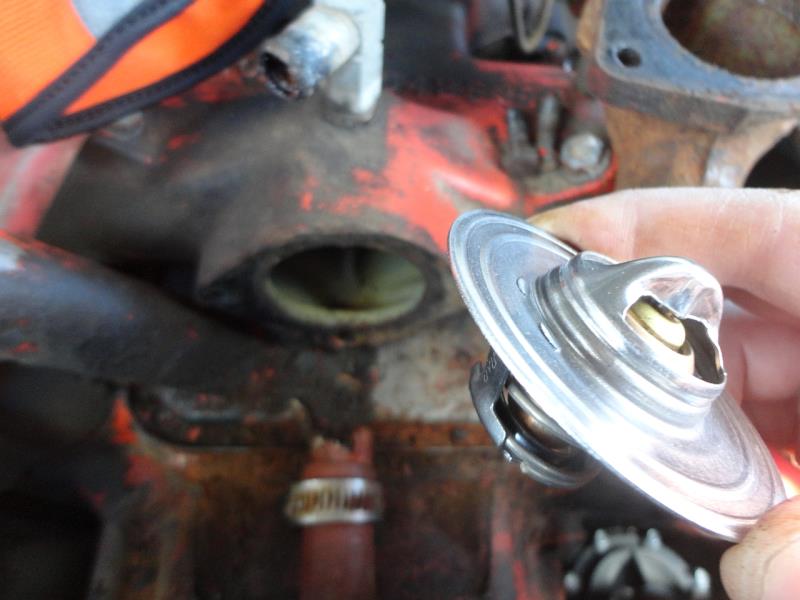
Yeah I've changed all the rubber hoses, though I haven't inspected the coolant pump or radiator..
|
|
By stuey - 10 Years Ago
|
Hello there
"The most evident thing was the white smoke bellowing out of the tailpipe. >< "
head gasket trouble when up to temp. Maybe.
stuey
|
|
By charliemccraney - 10 Years Ago
|
If you remove the cap very slowly and carefully, with a few rags between it and your hand, it will not "explode." If you are not careful about it, then yes, you are getting burned, probably seriously. This is where the infrared thermometers are really handy. No need to risk removing the cap on a hot radiator.
|
|
By Half-dude - 10 Years Ago
|
I checked all the sparkplugs today, they all look fine, some are kinda rich but there's no weird foam or white color or any oddness like that.
A friend of mine is suggesting that maybe due to high heat or other reasons, a failure occurred between the water jacket and the nearest cylinder. Does this sound like a possibility? He admitted he didn't know much about yblocks.
|
|
By kansas - 10 Years Ago
|
I fought cooling problem on my 55 for 2 years turn out that it had a 5 1/4 inch water pump pulley on it, which moving the water through rad way to fast/check your pulley should be 7 1/4 inch
jim
|
|
By GREENBIRD56 - 10 Years Ago
|
So - If you simply run the engine up to temperature in the driveway, with the hood up and the radiator cap OFF (you could drive it around the block with the cap loose too) - then have a look down into the tank. What is going on then? A blown head gasket is to be suspected due to the "white" exhaust comment - bubbles would then be pumping into the upper tank - a visible sign for sure. You might have to add some water to get a good look. Losing exhaust into the water jacket can make the coolant very hot - very quickly.
I don't have direct experience with the sedan engines that have no waterpump spacer (T-birds are bad) but there should be signs of water moving in the upper tank when the thermostat is open. We had a fellow write in here one time (with a sedan), and his engine had an old waterpump where the impellor had sat and rusted so badly (vanes were missing and filled with gunk) - it simply wasn't pumping enough water. This becomes more serious with an auto trans - sitting in gear against the brakes - rpm is down low and both water pump and fan air flow is minimized.
I did notice in your photo of the thermostat - that it is the one with the 1.0 inch poppet - and that is a known flow restriction. The best one I've found is the "high flow" version - 160º temp - from Mr. Gasket. Mine opens wide and reliably at the rated temp - there is also a larger opening model available at NAPA that opens at 170º. The Y-block thermostat OD is the same size as a big block (426 - 440) Chrysler and sometimes easier to come by than asking for a 272/292/312 part.
|
|
By Half-dude - 10 Years Ago
|
GREENBIRD56 (8/31/2015)
Losing exhaust into the water jacket can make the coolant very hot - very quickly.
Thanks for the advice, I'll take it. I do want to correct one thing, I meant the intake manifold not the exhaust manifold. The idea is I think one of the two front water jackets is leaking across and into the intake of one of the first cylinders (1 or 8 I believe) If so, it looks like the coolant is getting burnt up and exhausted as there was wetness in the tailpipe. My buddy also once he saw the smoke said it wasn't white smoke like I thought it was.
Oh also the car starts right up like one or two seconds of cranking, he said it wouldn't start up that easy with a blown head gasket.
|
|
By Half-dude - 10 Years Ago
|
I sure hope my block isn't cracked.. I haven't had a chance to take my intake manifold off and check for leaks in the gasket. I'm just hoping it's not.. cuz I'll be screwed.
|
|
By junkyardjeff - 10 Years Ago
|
When my 55 was all original the temp gauge read almost all the way to hot even though it was close to 180.
|
|
By 2721955meteor - 10 Years Ago
|
|
stuey is the one that is most likeley corect,white smoke is a good indicator along withover heating of head gasket isues.
|
|
By Half-dude - 10 Years Ago
|
Well I got the water pump off today, nearly killed myself it felt like.. it was so friggin hot today. I ended up having to take the radiator off just to get the pump off. Though I'm pretty sure you guys already knew that, wasn't a huge deal since the system was drained already and it's only held on by four bolts. Hell, having it off the car will probably make it easier to flush it with a garden hose or something.
The pump looks okay considering, though it does have a bit of sludge along the back-plate where it meshes with the front of the block. It's pretty gross looking, kinda looks like mashed up green flax seeds. I do gotta say, those pumps sure do have dinky little impellers in them don't they? No wonder if it's not circulating very well. I'll post some pictures up here in a bit. I kinda wish I could get the pump taken apart, but I don't have a puller to take the hub off.
|
|
By Half-dude - 10 Years Ago
|
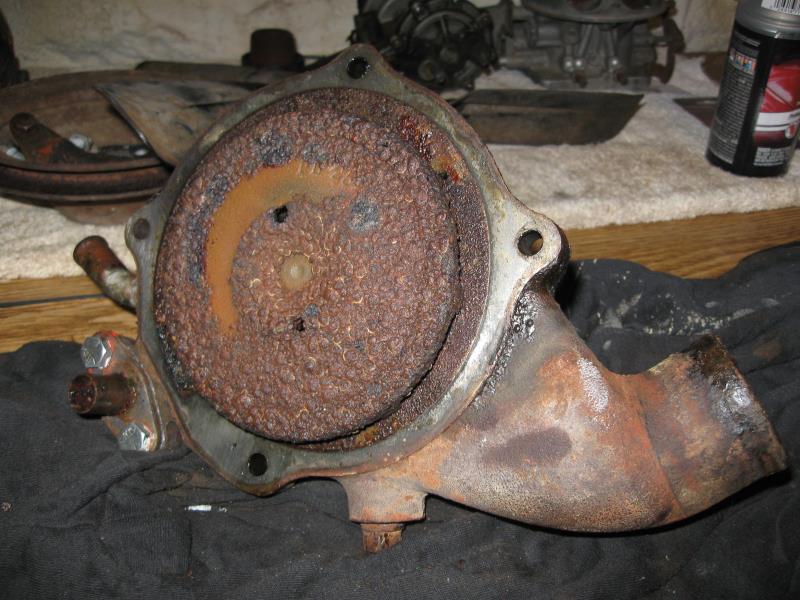
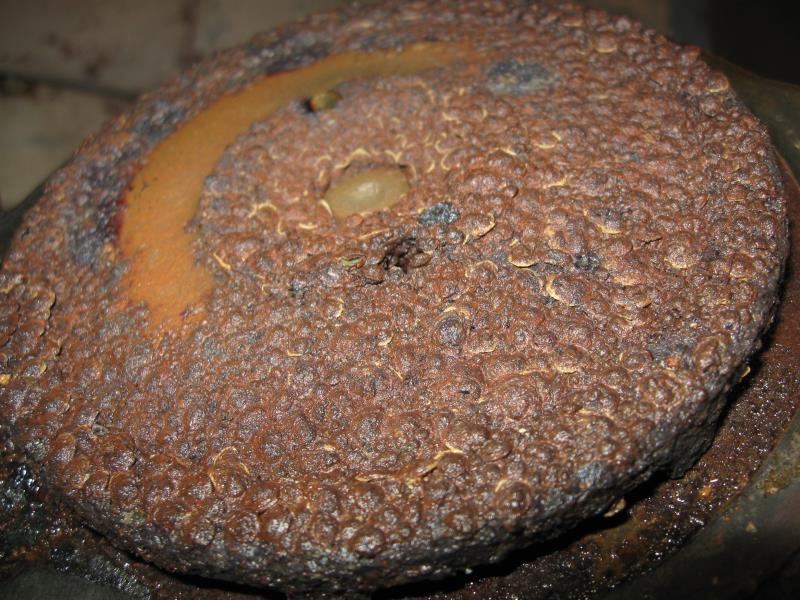
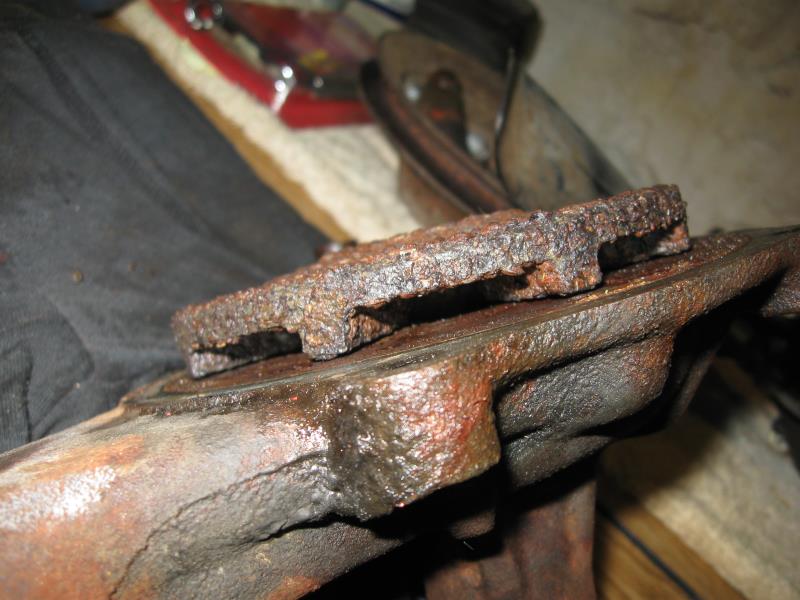
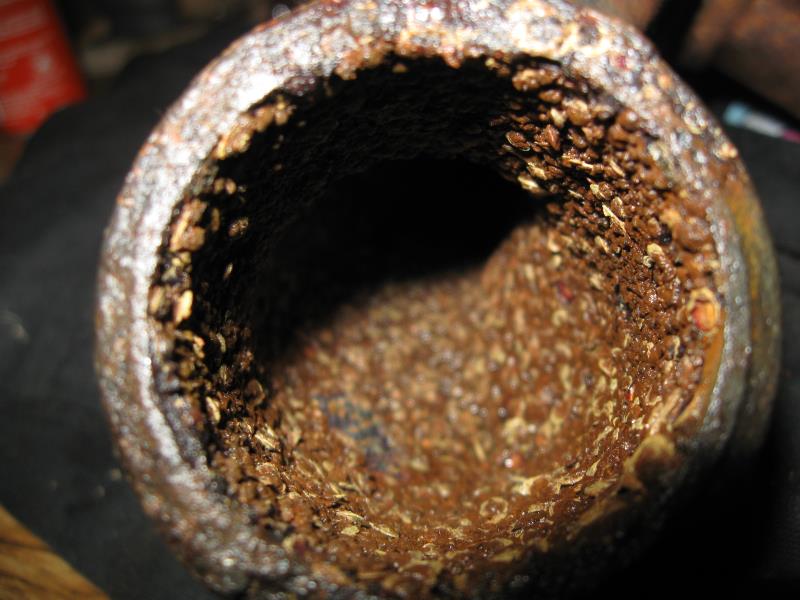
|
|
By 57RancheroJim - 10 Years Ago
|
It's time for a new pump. Take the radiator to a shop and have it cleaned out, I'll bet many of the tubes are plugged and a flush with a garden hose is worthless.
|
|
By 2721955meteor - 10 Years Ago
|
|
you have some real isues with rust and erosion ,the inside of the block will look the same.ther is a remote posibility you could clean the block with a mixture of muratic acid and water mix. leave it for a few days to work. becarfull ,use ruber gloves and gogles.rad is probebly the same.. my guess is you will need to remove the engine strip it and have it hot tanked.also look at front cover eaten up wher water flowes. looks like a case of years of running with no anty freeze and hard water.
|
|
By Half-dude - 10 Years Ago
|
2721955meteor (9/7/2015)
you have some real isues with rust and erosion ,the inside of the block will look the same.ther is a remote posibility you could clean the block with a mixture of muratic acid and water mix. leave it for a few days to work. becarfull ,use ruber gloves and gogles.rad is probebly the same.. my guess is you will need to remove the engine strip it and have it hot tanked.also look at front cover eaten up wher water flowes. looks like a case of years of running with no anty freeze and hard water.
I don't know. Obviously I can't see inside the deep parts of the engine. But I've seen a lot of the water passages in the upper part, inside the intake manifold, in the cylinders when I had the heads off.. and this is the first place I've seen this crud. Even that crud that's in the intake pipe, it's only around the first couple inches inside and then it clears up. Here's some pictures of what the water jackets in other parts of the engine look like, they're pretty clean.
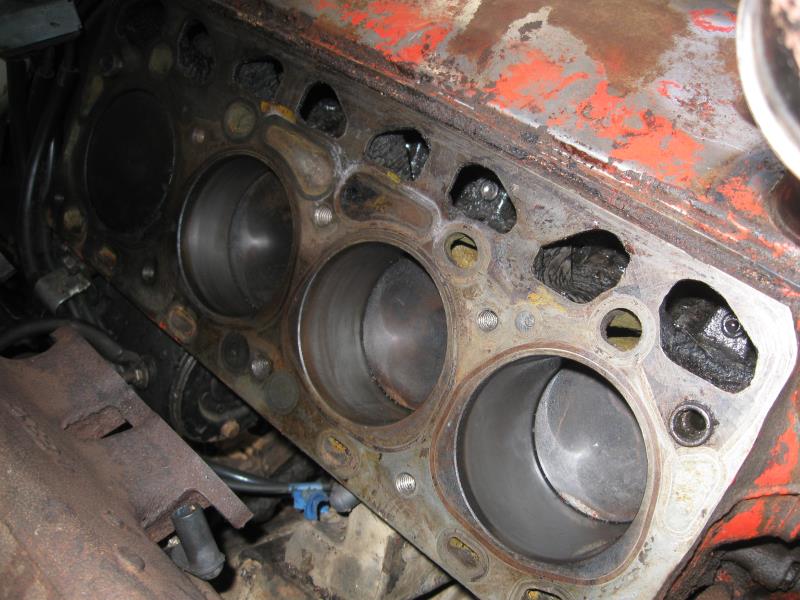
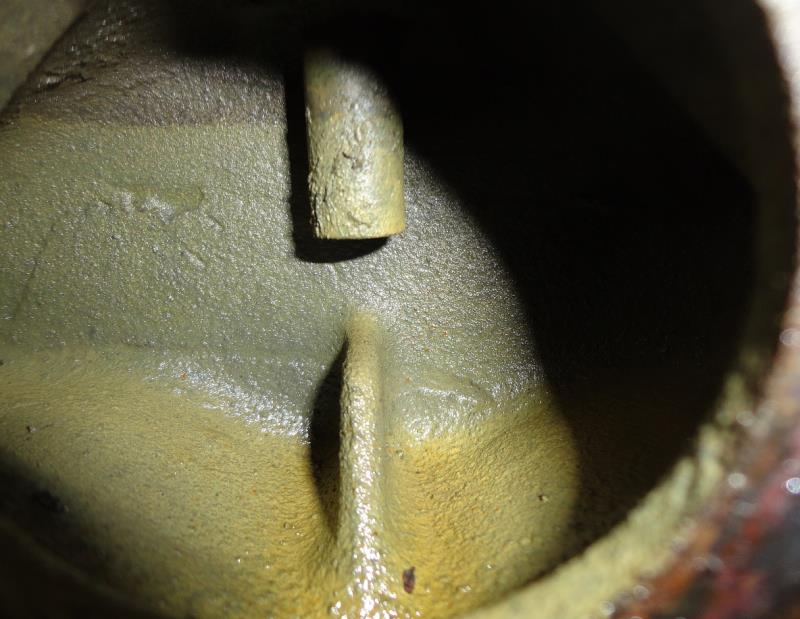
Inside the intake manifold ^^^^
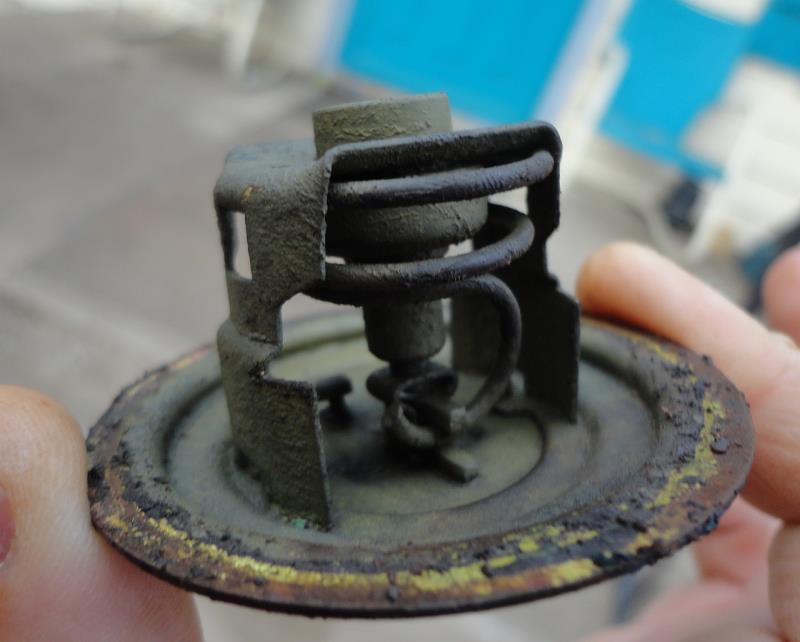

|
|
By 2721955meteor - 10 Years Ago
|
|
block looks ok,tho crud usualley gathers on the outer arias of the block,just remove core plugs to be sure,ther ar ruber expanding plugs so it is easey to replace core plugs.
|
|
By GREENBIRD56 - 10 Years Ago
|
Half-Dude - this business of finding the pump iron to be much more corroded than the actual engine block, has to do with the chemistry of the iron used for casting each. The blocks are much harder. Your photos don't look too unreasonable to me for an ancient engine block - and many of us are running them "as-is". Tanking is a choice reserved for " total rebuild -as new" - not the usual, work in place - get'er running deal we all get faced with sooner or later..
Yes - see if you can round up a newer water pump - you are wanting a cleaner newer impeller for sure (and a fresh shaft seal). I have found that there are several versions of the impellor around - some have more or less vanes in fact, just depends on who made the replacement parts (Ford vendor or others). We've discussed the thermostats before - I believe the right part number at NAPA is a "#6" - which gets a 170º opening model - with a 1.50 poppet opening. Also - look for a set of the "truck" intake manifold gaskets - the exhaust cross-over passage has a built-in shim steel restriction - it helps reduce fuel percolation problems from a "hot shutdown" in summer weather.
When she is back together, consider running the engine with a big dose of white vinegar for awhile. The acidic solution will really release some gunk - keep changing the water. And flushing - and re-dosing with the white vinegar.
|
|
By Half-dude - 10 Years Ago
|
So I got some more inspecting done on the Ford.
I got to do some compression testing, I'm a bit underwelmed about the results, most of the cylinders are only getting about 110 to 120 pounds of pressure. But they all seem mostly uniform so that's good I guess.
Here's the real kicker though, it looks like the intake pushrod on cylinder 5 feel off the lifter and wasn't opening, or intermittently opening the valve. I'd just done a valve adjustment on the engine before it started smoking so maybe that was what was casing the smoking.
|
|
By charliemccraney - 10 Years Ago
|
That can cause smoking.
|
|
By Half-dude - 10 Years Ago
|
So I've heard. Though I myself don't understand how. It's good to hear though.
|
|
By Rusty_S85 - 10 Years Ago
|
GREENBIRD56 (9/10/2015)
Half-Dude - this business of finding the pump iron to be much more corroded than the actual engine block, has to do with the chemistry of the iron used for casting each. The blocks are much harder. Your photos don't look too unreasonable to me for an ancient engine block - and many of us are running them "as-is". Tanking is a choice reserved for " total rebuild -as new" - not the usual, work in place - get'er running deal we all get faced with sooner or later.. Yes - see if you can round up a newer water pump - you are wanting a cleaner newer impeller for sure (and a fresh shaft seal). I have found that there are several versions of the impellor around - some have more or less vanes in fact, just depends on who made the replacement parts (Ford vendor or others). We've discussed the thermostats before - I believe the right part number at NAPA is a "#6" - which gets a 170º opening model - with a 1.50 poppet opening. Also - look for a set of the "truck" intake manifold gaskets - the exhaust cross-over passage has a built-in shim steel restriction - it helps reduce fuel percolation problems from a "hot shutdown" in summer weather. When she is back together, consider running the engine with a big dose of white vinegar for awhile. The acidic solution will really release some gunk - keep changing the water. And flushing - and re-dosing with the white vinegar.
I haven't heard of the vinegar trick before, and not to hi-jack this topic what will this exactly clean out? I thought of doing the acid and water mix on mine since my new rebuilt radiator is already starting to get chunks from the block in the top of the radiator from months of running it and looking at cleaning the whole system out safely without damage to other parts especially the new parts I have.
|
|
By Dobie - 10 Years Ago
|
|
It's another approach to the acid trick, just less harsh. It will loosen/dissolve rust and whatever else the acid in the vinegar can attack. Be sure to neutralize any acid or vinegar remaining in the system with baking soda when you're through flushing.
|
|
By Rusty_S85 - 10 Years Ago
|
Sounds better than the acid which i have but I've been reluctant to use out of caution.
The baking soda is there any amount you need to add to the cooling system to neutralize the acidic nature of the vinegar after flushing?
|
|
By Dobie - 10 Years Ago
|
|
At least one box of soda. You may want to do the neutralizing procedure twice, using 1 box of baking soda each time. then flush with plain water. If you can find canning vinegar it's a little stronger than the salad vinegar on the grocery store shelf.
|
|
By newbill - 10 Years Ago
|
Evaporust came out with a new product for cleaning the scale out of cooling systems recently. I tried it in my Model A, and I was amazed. Might give that a try.
|
|
By DryLakesRacer - 10 Years Ago
|
|
Going back to you first photos of the Town Sedan and engine I noticed an exhaust crossover pipe. As I knew them all 55 Fairlane 4 barrel engines had dual exhaust and no crossover. This adds a lot of heat under the hood so you may want to consider factory duals with rear exit exhaust manifolds. Good luck.
|
|
By Half-dude - 10 Years Ago
|
Okay I finally took Mitzi out for a drive today with a temperature gun on standby. I ran her until she started wanting to die at idle like she does and when the TEMP guage was reading a up on the hot end probably less then a inch from the far hot end of the gauge.
Intake Manifold Thermostat Housing: 212
Upper Radiator Hose: 188- 196
Upper Radiator: 176-177
Lower Radiator: 130-140
Lower Radiator Hose: 140-150
How do those look to you guys? By what you're saying it doesn't sound like it's too bad but she's definitely running on the hot end of things. I'm thinking of taking the thermostat out and running her without one and see what I get.
|
|
By charliemccraney - 10 Years Ago
|
With a good functioning cooling system, the engine should run near, but above the thermostat rating. What temp is the thermostat?
Don't run it without a thermostat.
Did you replace that water pump?
|
|
By Half-dude - 10 Years Ago
|
That's the problem, I don't know what the rating is, I didn't bother to find out when I got it.. I was new to working on cars at the time and didn't know they came with different ratings... why shouldn't I run without a thermostat? I've heard of other people doing that.
Yes I did put the new pump on.
|
|
By charliemccraney - 10 Years Ago
|
If you're having cooling problems, it is nothing that removing the thermostat will truly fix. You simply need to find the problem and fix it correctly.
With no thermostat, it will probably run too cool, assuming everything else is good. The engine will take longer to warm up. Heater performance is not as good. Mileage will decrease. Power will decrease. Engine wear will increase. The temperature will not be regulated at all. Other issues could arise as a result of having a gaping hole, rather than the restriction provided by the thermostat. It's not going to cause anything beneficial to happen and it won't fix your problem.
|
|
By Half-dude - 10 Years Ago
|
I took out the thermostat this weekend, turns out it was a 180 degree thermostat. I'm ordering a 170 degree NAPA THM 6 as someone here told me that was a good one, I kinda think I'd rather get a 160 degree one though.
|
|
By charliemccraney - 10 Years Ago
|
180 should be about perfect. 160 is too cold. The thermostat is not your problem, assuming it is working correctly. You can check that in a pot of water, as you bring it to a boil, or with a heat gun and infrared thermometer.
|
|
By Half-dude - 10 Years Ago
|
charliemccraney (9/30/2015)
180 should be about perfect. 160 is too cold. The thermostat is not your problem, assuming it is working correctly. You can check that in a pot of water, as you bring it to a boil, or with a heat gun and infrared thermometer.
I ended up installing a 170 degree NAPA #6 thermostat. For the most part the gauge is staying right in the middle of the gauge or just about 3/4ths the way up at it's hottest. So it seems like my old thermostat was the problem as 3/4 or over was right where it used to sit by default. I think that old thermostat that was rated 180 actually didn't really open till 185/190, I actually did the boiling water test on it.
|